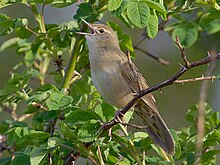Locustella naevia
| Common grasshopper warbler | |
|---|---|
 |
|
| Scientific classification | |
| Kingdom: | Animalia |
| Phylum: | Chordata |
| Class: | Aves |
| Order: | Passeriformes |
| Family: | Locustellidae |
| Genus: | Locustella |
| Species: | L. naevia |
| Binomial name | |
|
Locustella naevia (Boddaert, 1783) |
|
The common grasshopper warbler (Locustella naevia) is a species of Old World warbler in the grass warbler genus Locustella. It breeds across much of temperate Europe and western Asia. It is migratory, wintering in north and west Africa. The genus name Locustella is from Latin and is a diminutive of locusta, "grasshopper". Like the English name, this refers to the characteristic insect-like song of the common grasshopper warbler and some others in this genus. The specific naevia is Latin for "spotted ".
This small passerine bird is found in short dense vegetation, often close to water. It is a medium-sized warbler about 13 cm (5 in) long. The adult has a streaked brown back and whitish grey underparts which are unstreaked except on the undertail coverts. The sexes are identical, as with most warblers, but young birds are yellower below. Like most warblers, it is insectivorous. Four to seven eggs are laid in a nest on or near the ground in thick vegetation or in a tussock of grass.
This is a species which skulks in the undergrowth, creeping through bushes and low foliage, and which is very difficult to see except sometimes when singing from a prominent position. The song, which gives this species its name, is a monotonous mechanical insect-like reeling, often given at dawn or dusk.
The adult common grasshopper warbler (the name is the IOC recommended English name) has a length of about 12.5 cm (5 in). It is a very secretive bird and seldom seen, but its presence is easily detected because of its characteristic song. The upper-parts are pale olive-brown, each feather having a central darker brown streak. The cheeks are greyish, the irises are brown and there is a faint eye streak behind the eye. The upper mandible of the beak is dark brown and the lower mandible yellowish-brown. The underparts are cream-coloured or yellowish-buff with a few dark brown spots and streaks on the breast and flanks. The wings are brown with the outer edge of the feathers rimmed with paler brown. The tail feathers are reddish-brown with faint transverse bars being visible in some individuals and the under-tail coverts are streaked. The slender legs and the feet are pale yellowish-brown.
...
Wikipedia

